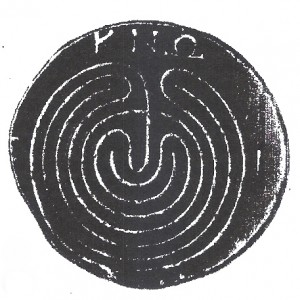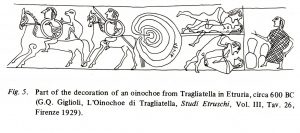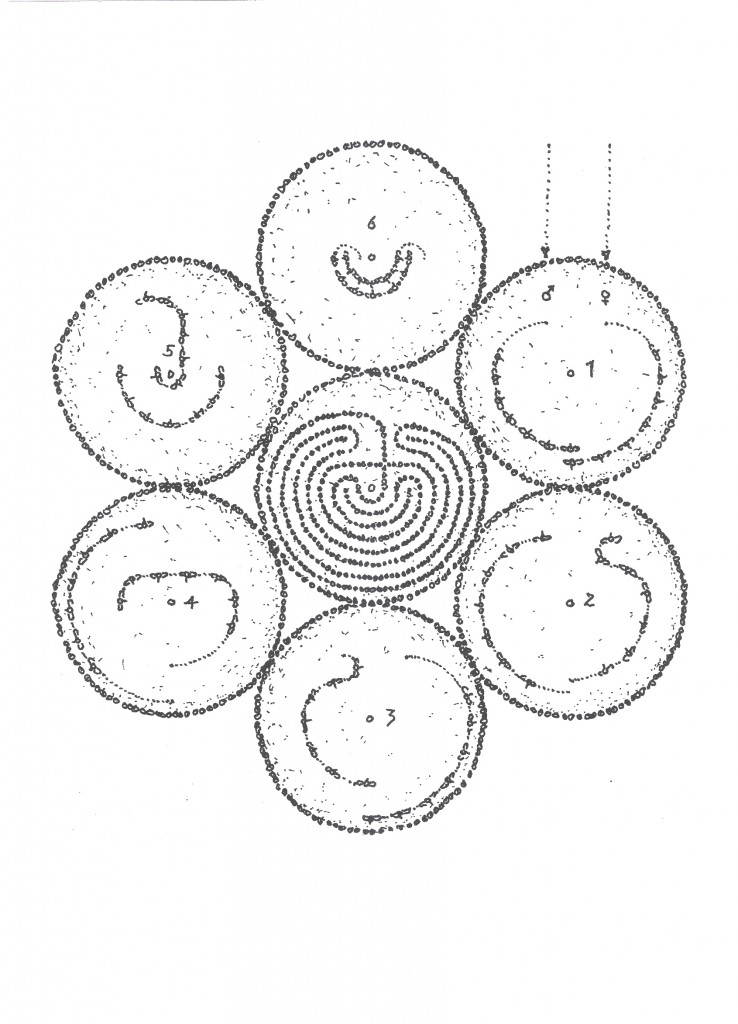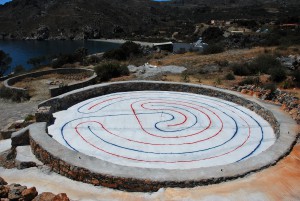Meaning of a worldwide famous symbol
Known as ” Cretan Labyrinth ” double lines are choreographic guidance of a
dance described by Homer and Plutarch , a ritual mating dance of the Minoan period , the Geranos .
Translated by Manuela Gallina (mgmultilingual@gmail.com)
Labyrinth
λαβύρινθος. Many concepts can be associated with this Pre-Greek word, which probably entered the Greek language and writing in onomatopoeic form.
On the one side we understand a ‘labyrinth-like building’. A cave, a house with many doors, a situation without escape, a confusing destiny in which one got into, and from which it is very difficult to come out. The origin of this form according to today´s understanding comes from the Cretan myth of the housing of the Minotaur. Theseus found the entrance and inside the Minotaur that he heroically killed in order to free the Athenians from the spell that every 8 years 7 noble female and 7 male maidens were sent to Crete as a bloody prey for the monstrous Μῑνώταυρος. Without Ariadne´s thread, which she collected into a ball from her wall tapestry as a sign of love for him to help him find his way out of the disorientating labyrinth, the shining king´s son would have gotten lost after completing his mission.
The entire world searched for this building. And already in the Classic Age an underground ancient piece of stone was found near Gortyn on the Southern part of the Ida Mountains, which was considered to be the housing of the Minotaur. Already in the 19th Century fascinated curious tourists would undertake pilgrimages to this artificial cave. And this continued till the beginning of the 20th Century, when Sir Arthur Evans published his discovery with his excavation in Knossos (ancient Greek Κνωσό or Κνoσό) near Heraklion. A reconstruction model of the temple palace in the Archaeological Museum in Heraklion (AMI) shows what already in the Ancient times was described as a labyrinth-like building.
 What will be dealt with in this essay is a symbol described as ‘Cretan labyrinth’ or ‘labyrinth of Cretan type’ that is composed of two intertwined lines. It is depicted sometimes as round and sometimes as square on some silver coins that were found in Knossos. They did not come from the Minoan period but rather form the 5th Century B.C. Because of the inscriptions ΚΝΩΣΙΩΝ they are doubtlessly dated back to Knossos.
What will be dealt with in this essay is a symbol described as ‘Cretan labyrinth’ or ‘labyrinth of Cretan type’ that is composed of two intertwined lines. It is depicted sometimes as round and sometimes as square on some silver coins that were found in Knossos. They did not come from the Minoan period but rather form the 5th Century B.C. Because of the inscriptions ΚΝΩΣΙΩΝ they are doubtlessly dated back to Knossos.
In the thick manual by Hermann Kern[i], in which he dedicates his research exclusively to this symbol, we can find similar symbols worldwide.
Interpretation attempts can fill countless books. They witness the fascination for these both lines, despite the fact that they are just lines, after all. Can there be something more that Hermann Kern and all the other authors missed out on?
Omen
λάβρυς is originally a lyric term for a double-axe. Etymologists Maximilian Mayer and Paul Kretschmer encountered the word in the name of Canary god of war Labraynda.[ii] The double-axe or double-bladed axe was the fight axe in the Scythian peoples and of the mythical Amazonian people. For the Minoan civilization it was a sacral symbol. Numerous symbols of it were found in different sizes in Minoan worship places such as the Cave of Psychro and Arkalochori. They are normally made of bronze, but also gold and silver. They might have gotten the form from a sacrificing instrument that was used for the sacrifice of a holy bull. Both bent edges merge to the middle into a hook through which a golden handle was attached. The latter was on a base sheet that showed the symbol. In the edges there are partly engraved or fully visible linear motives as in a Lavris from Zakros.
Together with the ending –ινθος, which refers mostly to a geographic definition, the word labyrinth (= place of the double axe), was referred after the excavations by Evans to the palace temple of Minoan ruler. A piece of evidence to confirm this assumption is the early mentioning of the word around 1400 B.C. on a clay panel from Knossos palace that was written in linear B. From the pre-Homeric Greek this inscriptions’ translation means “to the ruler of the honey of the labyrinth” and it is apparently a simple sacrifice instruction as Karl Kerényi writes in his Greek Miniatures.[iii] We can thus infer for sure that the Greek conqueror of Crete applied this name on the palace temple at least in Knossos from their constructors, the Minoans.
If this hypothesis is correct, then the Minoans did not associate the word labyrinth with a place in which one gets lost. It would also be quite unlikely that we perceive a place in which we move daily as a disorientating place. Such feelings were associated by foreign conquerors with the birth of a Minotaur, a man with a bull´s head, who was kept prisoned in a labyrinth.
The Minoan initiation ritual of keeping young people on the verge to adulthood in the darkness of cold and humid caves by priests with a bull mask[iv] that were meant to frighten them could have easily been converted into a horror story on the part of the conquerors as an attempt of history falsification. Here emerges also the connection to a cave in which the Minotaur must have been kept prisoned. In the thousand of years from the decay of Minoan domination until the rising of this mocking myth, the word association of frightening confusion with the name of the Minoan palaces must have originated, in fact afterwards this spread everywhere throughout the Greek world.
At this point, a divine figure appears in the myth: Daedalus. He is the epitome of a star architect of the Ancient times. As born Athenian (thus with a sharp mind) he is assigned by king Minos to build all the works of art that would leave such a good impression on the following generations. Not only did he build the temple palace of Knossos, but also a dance palace for the already mentioned Ariadne that is praised by Homer in the Iliad as he described Achilles` shield made by Hephaestus:
Therein furthermore the famed god of the two strong arms cunningly wrought a dancing-floor like unto that which in wide Cnosus Daedalus fashioned of old for fair-tressed Ariadne. There were youths dancing and maidens of the price of many cattle, holding their hands upon the wrists one of the other. Of these the maidens were clad in fine linen, while the youths wore well-woven tunics faintly glistening with oil; and the maidens had fair chaplets, and the youths had daggers of gold hanging from silver baldrics. Now would they run round with cunning feet exceeding lightly, as when a potter sitteth by his wheel that is fitted between his hands and maketh trial of it whether it will run; and now again would they run in rows toward each other. And a great company stood around the lovely dance, taking joy therein; and two tumblers whirled up and down through the midst of them as leaders in the dance.[v]
The dancing square mentioned in the classical translation by Thassilo von Scheffer[vi] (Gr. xορός) can also be translated as dance, round dance or similar.
If we followed Homer, then the invention of Daedalus could also have been a choreography that was danced somewhere or in the palace of Knossos. Evans as well as further archaeologists have not found any dance square yet that fits the description by Homer. The big central court within the palace building is perfect as stage for representations with its surrounding galleries and even a sort of royal lodge. So you can imagine that the famous bull jumping that is so popular and represented in frescoes and coins took place there, too. The numerous audience of such an event is shown by a well-preserved fresco from the palace. One after the other next to each other are depicted Minoan-like dressed women and behind them are the men.
Can it be that the intertwined lines that we also know from the coins represent nothing but choreography?
Lines of demarcation
The interpretation of the lines in the aforementioned literature starts from the assumption that walls or generally speaking borders are represented through the lines, that is to say borders within which one can move. The Cretan labyrinth accepts only one path under these circumstances: through an opening in the outer border one can enter it and it leads through 7 winding paths between the lines towards the center. The latter is composed of a small round, which is totally unspectacular. Confusion is impossible. If one wants to go out again, then one can just turn back and come back through the same path.
Is that it?
Such a walled-up ‘labyrinth’ of this kind that was build on the base of the lines cannot have been the housing of the Minotaur. Theseus would not have needed any help from Ariadne. Moreover, if we had found such a labyrinth, we would never get lost either. It might become a bit odd to follow the intertwined path. On a second time we would know already and we would not get lost in it. Our imagination of a labyrinth as a place of uncertainty does not correspond to such a building concept. Especially not if it is planted as a garden hedge and cut in undulating forms. Once we have reached the middle, we ask ourselves what is the meaning of it. On an Etruscan wine jar from the 7th Century B. C. the symbol is carved in the same way as the Cretan labyrinth (just flipped horizontally).
 Next to it one can see, for sure as a kind of ancillary comment, two copulating couples. Would we fantasise like this after an inspection between the lines of demarcation? The jar is very telling also for another reason: between the intertwined lines in the typical form, the word TRUIA is carved on the left. The definition ´labyrinth‘ for the line symbol is thus not constant. The Christian Middle Age conveyed and represented the labyrinth symbol as a wrong path that we go across in this life on Earth. Artful drawings of walled-up wrong paths follow somehow the form of the Cretan line play. They show various ramifications that end up in blind ways. In the broader center waits the Minotaur as representative of the Devil, which one is due to overcome. This is still determinant for our current concept of such a labyrinth as a symbol for the purification or even redemption after wrong paths and errors, which corresponded to the granted assumptions of Christian religion. Thus a definition of our line symbol as ‘labyrinth’ is misleading.
Next to it one can see, for sure as a kind of ancillary comment, two copulating couples. Would we fantasise like this after an inspection between the lines of demarcation? The jar is very telling also for another reason: between the intertwined lines in the typical form, the word TRUIA is carved on the left. The definition ´labyrinth‘ for the line symbol is thus not constant. The Christian Middle Age conveyed and represented the labyrinth symbol as a wrong path that we go across in this life on Earth. Artful drawings of walled-up wrong paths follow somehow the form of the Cretan line play. They show various ramifications that end up in blind ways. In the broader center waits the Minotaur as representative of the Devil, which one is due to overcome. This is still determinant for our current concept of such a labyrinth as a symbol for the purification or even redemption after wrong paths and errors, which corresponded to the granted assumptions of Christian religion. Thus a definition of our line symbol as ‘labyrinth’ is misleading.
If we now imagined no walls nor demarcation lines but leading tracks for a ritual dance, would we then come closer to the original meaning?
Dance
Χορός. The Greek word for dance or round dance can mean as aforementioned the place of dance or the dance square. It is also used for choreographers and playwrights during the Dionisos celebrations in Hellenic times. The word is related on a merely auditory level to χώρα, χώρη or χώρος = rural village or generally the delimited spot in the landscape. If we observe a village dating back to the Minoan Age, then we would find a place that is fixed with stones: the threshing spot (new Gr. αλώνι). You can still find it in Crete especially in places that are possibly exposed to the wind. The chaff was sacrificed to Aeolus, the God of the Winds. The spots have a diameter of about 9 to 12 m and are delimited at the edges with big stones. Exactly in the middle of the circular place there is a stake in the ground. A donkey with a leash was attached to it and still is today so that it keeps the round beautifully during the pulling of the threshing sled (Gr. βολόσυρος). By doing this, it wraps the thread around the stake by itself and it becomes shorter so that in the end all the grain available is threshed with the sled.
What does it have to do with the dance or with the ‘labyrinth’ at all?
In some villages this spot might have been the only surface with fixed stones in the entire village. That is, the only place that was also ideal for dancing.
Let us imagine marking both intertwined lines of our symbol onto such a threshing place. We prepare a wire in which we knot a small loop at every 50 or 60 cm. We prepare the one end of the wire with a loop around the central stake. In this way we can mark eight concentric half circles on one half of the threshing place, as if we had a compass. We then complete the other half in the same way as the Cretan labyrinth. If we have chosen a distance of 50, then the outer half circle has a diameter of 2 x 8 x 0,5 = 8 m, corresponding to 60 cm 2 x 8 x 0,6 = 9,6 m. In this way it fits very well inside of the threshing place. Now we have before us a dance place with a marked choreography consisting of two intertwined lines like in the center of the following sketch.
We remember the Homeric description of the dancing people: female and male virgins compose two separate chorus-performing groups according to the gender. The word chorus is used in herewith in its original Greek meaning (= dance). The groups are made of seven chorus-performers each. Analogously to the „Συρτός χορός [„the dragged“, „towed“ or „pulled dance “] that is still danced today, the dancers here hold hands. That is, the dancers stand with two shoulders parallel to the dancing direction. “People dance with six steps on a 2/4 pace with the dancing rhythm long-short-long, long-short-short. The dancing direction is towards the right, that is clock-wise, and in the basic form the dancing people move forward with each step in the dancing direction. In the step sequence right and left foot interchange and the right foot starts.“[vii] In the beginning, the row of seven male dancers stands behind the seven female dancers outside of the threshing place. If the minstrel starts as according to the description by Homer in the middle with an introduction of his play with the lyre, the coryphaeus proceeds (Gr. χορηγός, dor. χοραγός) followed by the chorus members in the circle of the threshing place on the external start each and every one following the line. There they wait until the minstrel starts to sing. Now they follow the marked lines in the rhythm of the singer and the steps of syrtós. The dance is divided into six choruses, whose changing points are marked on the lines. The coryphaeus watches out carefully that they reach the marks at the chore changes.
In the first chorus (described in the sketch with 1) the male virgins look towards the center of the circle, while the female virgins show themselves to the audience standing outside with hands stretched to the back. At the end the chorus members meet with their face turned away from each other. In this position, dancing passed each other, they complete the circular movement in the second chorus (2), at the end of which the young men turn outwards, so that they can now show themselves to the audience in the third chorus (3), while the female virgins turn towards the center contrapuntally. At the end of it both groups meet once again with their faces turned away from each other, but this time the young men are looking towards the outside, and the young women towards the inside. The female virgins cross the line intersection in the fourth chorus (4) by carrying on their dance in this way, while the young men complete the started circular movement in order to later turn towards the center of the place in the fifth chorus (5). Now it is the latter who cross the line intersection by dancing and later on circle around the middle stake. The female virgins complete their commenced circular movement. At the end of this chorus both groups look in each other´s eyes for the first time, the young men gazing externally, the female dancers internally. Suspense increases. In a very closely danced turnaround at the beginning of the sixth chorus (6) both groups change the gazing direction. Once both coryphaei come to stand and stop at the end of the lines, each one of the seven female virgins has her arms turned to her back in the cubitus valgus position that is so popular among young girls and looks into the eyes of one of the seven young men, who gives himself airs with his shoulders in a virile way and bends forward.
It´s crackling!
Géranos
Γέρανος. Géranos (female in ancient Greek) is the crane. In old texts a dance was also named after this bird name, which imitated the courting behaviour of cranes. Greek biographer Plutarch related:
Nach seiner Abfahrt von Kreta landete Theseus in Delos, […]. Hier führte er auch mit den Jünglingen einen Tanz auf, der noch jetzt bei den Deliern üblich sein soll und zur Darstellung der Windungen und Irrgänge des Labyrinths aus mancherlei Wendungen und Beugungen bestand, die in einem gewissen Rhythmus ausgeführt wurden. Diese Art des Tanzes wird, wie Dikaiarchos meldet, von den Deliern Geranos genannt. Theseus tanzte ihn um den Keraton. Einem aus lauter linken Hörnern zusammengesetzten Altar.
[After his departure from Crete Theseus landed in Delos, […]. Here he performed also with some young men a dance that is said to still be popular among the Delians still today and consisted of representing the winding corridors and blind alleys of the labyrinth by means of several turnings and forward-bends that had to be performed in a certain rhythm. This kind of dance is called Géranos by the Delians, as Dikaiarchos reports. Theseus danced it around the Keraton, that is an altar put together with lots of left horns of male goats][viii]
Apparently, by mentioning the labyrinth, Plutarch follows here the identification of a labyrinth with the confusing construction filled with the maze of bind alleys that was already common in his time (1st Century A. C.). It can be doubted whether only the Delians called the dance Géranos. In fact, it is much more likely that already the Minoans called it like this. It can be ruled out that they called it after the name of their palace temple (Λαβύρινθος).
As we have seen, the illustrated choreography has the characteristics of a courting dance. We could even assume that the dance was part of a ritual initiation about which we know that such a dance played a major role for the Minoans. In the historical echo such a dance was associated with the myth of the Minotaur and thus to the labyrinth. Theseus struggles against the monster with the fresh experience of his fight and kills it on the journey back home to Athens on the island Delos. Here he lets people dance the Gérano dance that he had just learnt.
Modern arts historians such as Hermann Kern, with a PhD in law and autodidact in history of art, or Harald von Petrikovits[ix], historian of Antiquity specialised on history and culture of Roman provinces, examined a Roman variation of the labyrinth symbol that is the Lusus Troiae. The latter was described thoroughly by Vergil in the Aeneid.[x] Both have grappled with the interpretation of the lines as choreography. Kern wrote:
„Hier stoßen wir […] auf ein Problem, an dem schon v. Petrikovits gescheitert ist und das möglicherweise auch gar nicht gelöst werden kann: Die Labyrinth-Figur bietet nur eine einzige Bewegungsspur, die kreuzungsfrei von außen ins Zentrum führt. Platz wäre also nur für eine einzige Linie von Reitern, nicht aber für die von Vergil geschilderten zwei [es sind bei Vergil 3 Reitergruppen, MJU] Linien nebeneinander, die dann auch noch <nach links und rechts auseinandersprengen>.“ Und weiter „Bei der ursprünglichen Form des Rituals war sicher im Zentrum eine große Fläche als Wendeplatz notwendig“.
[“Here we are confronted […] with a problem that already v. Petrikovits failed to solve and that possibly nobody can solve: the labyrinth image offers only one movement track that leads from the outside to the center without crossings. That is, there would be space only for one single line of riders, but not for two adjacent lines as described by Vergil [for Vergil there are three riding groups, MJU], which disperse from each other to the left and the right.” And further “In the original ritual form a big surface in the middle was surely necessary as a turning area.” ][xi]
Not only does Kern close his mind against the dance choreography by considering the lines consistently as demarcation lines, but he also draws the line windings even reversed left to right in the first illustration of his voluminous work.[xii] In this way he puts himself a stop to an interpretation as Géranos dance.
As we can see, the labyrinth is quite an interesting issue for itself. The symbol generates wondering and confusion. By dancing the Geranos we can forget about them and dedicate ourselves fully to one of the most beautiful expressions of human life, that is Eros.
[i] Hermann Kern, Labyrinthe, München 1982
[ii] Günther Kehnscherper, Kreta-Mykene-Santorin; Leipzig-Jena-Berlin 1978
[iii] Karl Kerényi, Griechische Miniaturen, Zürich 1957
[iv] A Greek coin from Knossós dating back to the 4th Century B.C. shows a nude male dancer with a bull mask. Cretan ringlets spring out on both sides of the mask.
[v] Homer. The Iliad, trans. by A.T. Murray, Ph.D. Cambridge, MA., Harvard University Press; London, William Heinemann, Ltd. 1924
[vi] Homer. The Iliad 18, 590-606, trans. by Thassilo von Scheffer, Wiesbaden 1938
[vii] Page „Syrtos“. In: Wikipedia, The free Encyclopedia. Stand: 12th December 2010, 10:17 UTC. URL: http://de.wikipedia.org/w/index.php?title=Syrtos&oldid=82553223
[viii] Plutarch, βίοι παράλληλοι, Theseus 21.1-21.2 Trans. by J.F. Kaltwasser, Leipzig 1797
[ix] H. v. Petrikovits, Trojaritt und Geranostanz, Klagenfurt 1952/53
[x]. Vergil, Æneid, 5th book, vv. 544 – 603
[xi]H. Kern, Labyrinthe, p. 106
[xii] Ebd., p. 34
In Spring of 2016 a dance area was built on the property of Souda Mare hotel in the South coast of Crete, with the guidelines for Geranos dance in the choreography of the so-called ‘Cretan labyrinth’. It enables the dancing of this initiation dance that was celebrated about 4,000 years by the Minoans.



Pingback: Das ‚Kretische Labyrinth‘ – Minotavros